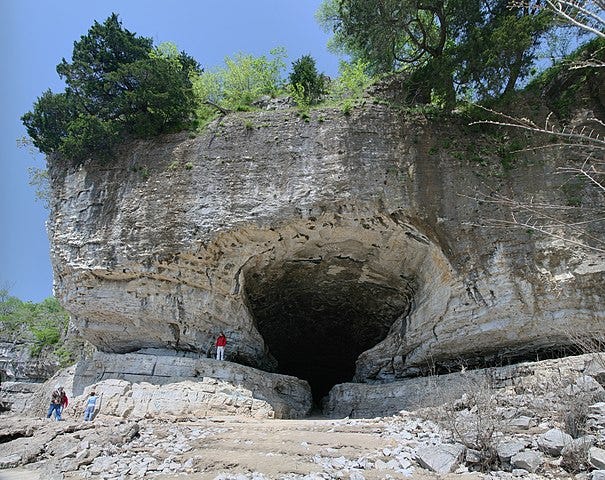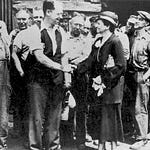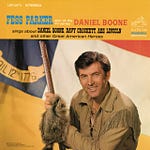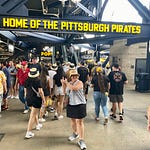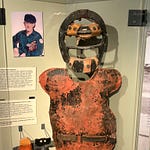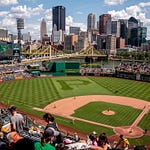Hello, friends.
For my personal update, I’ve been working with Joan Lunden on her legacy memoir, which will be published in March of 2026. Joan was the longest-running female host ever on early morning television, and her post-Good Morning America career has been equally fascinating and full. I’ll let you know when she settles on a title and cover design.
Next week, I’m headed out on my motorcycle to visit family in Arizona. I'm thinking of stopping in Roswell, New Mexico, because I am a connoisseur of roadside kitsch and conspiracy theories. The weather should be splendid. I’ll post the occasional picture on Instagram if you’re interested.
I’ll be back on the Ohio River in late August/early September for a BMW motorcycle rally in Athens, Ohio. If you’d like to get together, please reach out. I’d love to meet you in person.
Alright, on to the quiz. If you’ve read The Ghosts of Eden Park, you’re familiar with the role of the Ohio River in bootlegging, but it’s been used for lots of other illicit businesses over the years. Let’s see how you do with these ten questions.
Note to my fantastic new subscribers:
Monthly trivia is for sport. It’s not a test of intelligence or character. I couldn’t answer these questions without a significant amount of research, either! Do your best and enjoy learning something new.
QUESTIONS
Answers in the footnotes. Have fun!
Going back to the 18th and early 19th centuries, Ohio River criminal syndicates capitalized on the river's ever-growing traffic to evade taxes or to smuggle contraband humans and goods. We’ll come back to the trafficking of humans in a later question. What goods were the basis for most of the criminal activity along the river? More than one may apply.1
Tobacco and alcohol
Counterfeit currency
Everyday goods like textiles and grains
Newport, Kentucky, became a major hub for organized crime in the 1940s and 1950s while neighboring Covington, Kentucky, and Cincinnati, Ohio, did not. Which of the following reasons best explains Newport’s “success” as a crime town? More than one applies.2
It was small enough that local law enforcement could be easily influenced, but close enough to a major city (Cincinnati) to draw in big-money gambling customers.
Figures like Newport Police Chief Frank "Screw" Andrews openly worked with crime bosses rather than against them.
Unlike Ohio, Kentucky had looser gambling laws, creating a gray area where illegal casinos could flourish with little state interference.
Newport had a history of vice industries dating back to the 1800s, including brothels and saloons that made illegal activity feel like "business as usual."
Las Vegas-style casino operators, like Moe Dalitz (who later helped develop the Vegas Strip), used Newport as a testing ground before heading west.
Newport, Kentucky, was known as a mini Las Vegas due to its numerous illegal casinos. Which famous mob family was heavily involved in running these operations? Hint: It’s the oldest of the “Five Families” that dominate the New York and New Jersey region.3
a) The Genovese Family
b) The Gambino Family
c) The Dalitz FamilyWhich Ohio River city was used as a stand-in for New York City to film the recent gangster movie, The Alto Knights, starring Robert De Niro?4
Pittsburgh
Cincinnati
Louisville
The Fugitive Slave Act of 1850 effectively criminalized freedom for escaped enslaved people, which was a major force in Ohio River border states. While it didn’t classify freedom seekers as criminals by legal definition, it subjected them to punishment, forced capture, and denial of rights in ways that mirrored criminal prosecution—without any of the legal protections given to actual criminals. Which of the following is true of this Act? More than one applies.5
Unlike other legal systems where crimes have statutes of limitations, a fugitive slave could be hunted for life—even if they had lived freely for decades.
Anyone who helped a fugitive slave—whether by providing shelter, food, or transportation—could face fines of up to $1,000 (roughly $35,000 today) and six months in prison.
Slavery was legal under U.S. law at the time, so escaping from bondage was considered a violation of property law, similar to stealing a horse—except the “stolen property” was the person’s own body.
Freedom seekers were subject to hot metal branding, known as the “scar-based identification system.” This was believed to deter repeat escape attempts.
Blackbirding is the nickname for kidnapping free Black people and illegally selling them into slavery. If you watched the movie or read the book, Ten Years a Slave you will know about this history. Which of the following statements best describes how blackbirding networks operated north of the Ohio River before the Civil War? Choose one.6
They were loosely organized groups of bounty hunters who only targeted escaped enslaved people.
They were well-organized operations involving kidnappers, corrupt officials, and Southern enslavers who conspired to abduct free Black people.
They were illegal and faced harsh prosecution in free states like Indiana and Ohio.
They were primarily based in the Deep South and had no real influence in the Midwest.
A final question on human trafficking. What’s the difference between trafficking and smuggling human beings? Yes, this is an essay question.7
The 1962 film, How the West Was Won, featured Jimmy Stewart as a mountain man floating down the Ohio River with a group. Along the way, they stop at Cave-In-Rock, Illinois, where they meet a group of pirates led by Walter Brennan's character, Alabama Colonel Hawkins. Hawkins’ character was based on a real pirate who led a gang of outlaws there after the Revolutionary War. What was the name of the notorious gang at Cave-In-Rock?8
a) The James-Younger Gang (as in Jesse James)
b) The Harpe Brothers
c) The Exterminators
d) The Mason GangWhich Ohio River city’s police chief was a Prohibition-Era bootlegger?9
a) Newport, Kentucky
b) Madison, Indiana
c) Evansville, Indiana
d) Paducah, KentuckyHow did Kentucky, the heart of American bourbon production, handle Prohibition? Yes, this is an essay question, but I have faith in you.10
INTERMISSION
Did you watch the Ken Burns documentary Prohibition? Here’s the trailer.
ANSWERS
The most correct answer is a) because tobacco and alcohol were the primary goods being smuggled. That said, b) was also true, so give yourself credit for it too. Organized crime syndicates often transported fake bills up and down the river. By increasing the circulation of counterfeit money, it was difficult for authorities to track the counterfeiters.
As for option c), people certainly tried to avoid paying taxes and getting special licenses/permits for everyday goods but criminal syndicates weren’t interested in comparatively small change.
Newport was essentially the perfect storm of a small, corruptible town with a prime location and just enough legal gray areas to let organized crime thrive. All answers are correct. Here’s a link to Pivotal Dates in Gambling and The Law.
The correct answer is a) Genovese family. Interestingly, they made the news this month in a Supreme Court ruling on a murder-for-hire plot.
Cincinnati. The movie opened this month. Here’s the trailer, with De Niro playing two roles
Answers a) b) and c) are correct. Did you learn this in high school? I didn’t.
As for d), the practice of hot branding wasn’t part of the Act. In any case, branding was widely used in the Caribbean, not the States. Freedom papers and forged documents could override brands, so slave catchers relied on legal paperwork for payment. Many enslavers feared branding would reduce resale value, while others possessed a shred of decency that acknowledged the practice as inhumane.
The best answer is b). Blackbirding networks were not random bounty hunters but rather organized crime rings that included kidnappers, corrupt justices of the peace, and slave traders. These networks thrived in border states like Indiana, Ohio, and Illinois, where officials often looked the other way or were directly complicit in falsifying documents to re-enslave free Black people.
The United Nations defines human trafficking as “the recruitment, transportation, transfer, harboring, or receipt of persons by improper means (such as force, abduction, fraud or coercion), for an improper purpose including forced labor or sexual exploitation.” Read more about the how human trafficking works to this day here and here.
On the other hand, the definition of human smuggling according to U.S. Immigration and Customs Enforcement (ICE) is the “provision of a service—typically transportation or fraudulent documents—to an individual who voluntarily seeks to gain illegal entry into a foreign country.”
Trafficking is not confined to major urban areas like New York City, Atlanta, or Washington DC. It also takes place in quiet locations like the small town of Portsmouth, Ohio, where the opioid crisis is a factor in the crime of trafficking.
The correct answer is d). The Mason Gang of river pirates and highwaymen was led by Samuel Mason who robbed and murdered unsuspecting travelers after the American Revolution. Two of Mason's associates brought his head to the authorities to claim the bounty. The two gang members were recognized as pirates and were put on trail, eventually hanged in Greenville, Mississippi.
The following is an edited version of a post from WKMS: The trial of the two gang members is well documented and because of these transcripts, we have a good understanding of how Samuel Mason and his gang operated, according to Dr. Mark Wagner (interim director and staff archeologist of Southern Illinois Carbondale's Center for Archeological Investigations). The gang went out on boats and pretended to be interested in buying something from another boater, then robbed the people onboard and either stranded or killed them. Sometimes the victim’s boats were sunk, but other times Mason used his network of people along the river to sell the boat and goods to crooked merchants. There were others in this kind of scheme, but no one operated on the same scale as Samuel Mason.
Answer a) is incorrect mostly because the timing is off. Jesse and Frank James, along with the Younger brothers (Cole, Jim, and Bob), formed a gang of outlaws after the Civil War. Known as the James–Younger Gang, their robberies spanned from Iowa to Texas and Kansas to West Virginia, targeting banks, stagecoaches, and even a fair in Kansas City. There is speculation that the gang used Cave-In-Rock, but they tended to work further west.
Answer b) is incorrect because Joshua and William Harpe were likely cousins, not brothers, and more importantly, because it takes more than two to form a gang. The brothers grew up in Appalachian region of North Carolina-Tennessee and after their bloodthirsty crime spree began in 1798 they made it to Cave-in-Rock sometime in April, 1799. At first, they settled in with the Mason Gang but after they captured a flatboat together, the brothers took one of the flatboat’s captives, “lashed him naked,” blindfolded him, tied him to a blindfolded horse, hooped and hollered to beat the band and drove the pair one hundred feet off the edge of a cliff. The Harpes were kicked out of the Mason Gang and were once more on the run. Source.
Answer c) is the antithesis to a crime gang—they were vigilantes. "The Exterminators" formed in 1799 and raided the cave and the surrounding area, effectively destroying the ne'er-do-wells' hold on the site. More bandits moved into the space, but none stayed for long. In the mid-1800s the cave was even used as a church, while the small village that would come to be Cave-In-Rock was established nearby.
The correct answer is c) Evansville, Indiana. Here’s a quick documentary on Edgar Schmitt and his confederates.
Some distilleries managed to stay open legally by producing whiskey for "medicinal purposes"—one of the biggest loopholes in Prohibition law. The government allowed licensed distillers to produce and sell alcohol to anyone with a doctor’s prescription (through pharmacies like Walgreens, which expanded rapidly during this period). Distilleries like Brown-Forman (Old Forester) and Frankfort Distillery (Four Roses) survived Prohibition this way. The industry rebounded faster than in most states after the repeal of Prohhibition because Kentucky already had the aging bourbon supplies and infrastructure to resume production.
Corrupt politicians and law enforcement profited, keeping illegal alcohol flowing across the country. It wasn’t just whiskey that survived in Kentucky. Moonshining flourished in Eastern Kentucky’s Appalachian Mountains, where law enforcement had little control.




